Blockchain-Enabled Asynchronous Federated Learning in Edge Computing
Abstract
1. Introduction
- Decentralized federated learning: blockchain-enabled FL provides a decentralized global model convergence environment, in which all model updates will be verified by the blockchain consensus algorithm and stored on public ledgers in a decentralized way.
- Efficient asynchronous convergence: FedAC enables asynchronous local model training, updating, and global model aggregation. It can improve efficiency by avoiding the standby time of high-performance local devices.
- Robust system: By avoiding Single-Point Failures, model training process cannot be interrupted or suspended. Besides, blockchain provides extra secure protection for cyberattacks such as poisoning attacks.
2. Related Works
2.1. Synchronous and Asynchronous FL
2.2. Edge FL
2.3. Decentralized FL
2.4. Heterogeneity and Communication Cost
3. System Modeling
3.1. FedAC with Staleness Coefficient
| Algorithm 1 FedAC |
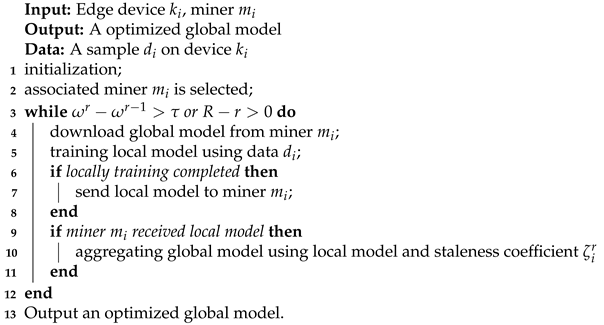 |
3.2. Decentralized Federated Learning Using Blockchain (FedBlock)
| Algorithm 2 FedBlock |
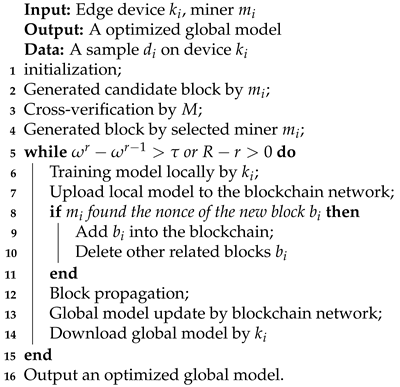 |
4. Evaluation and Experimental Preliminaries
4.1. Physical Environment Deployment
4.2. Federated Learning
- Non-IID: The data held by some particular devices have specific features that do not exist on the majority of devices.
- In order to protect user privacy, federated learning is adopted as the distributed computation framework for federating data holders. This may lead to a larger number of participants than classic machine learning.
- Data size imbalance: Due to the heterogeneity of training devices and differences of working environment, some devices may possess more examples, while others hold less.
- Limited resources and poor network quality: The first constraint is also due to the heterogeneity of devices. Besides, in real edge environment, edge devices may work in unstable and unreliable networks, i.e., mobile phones may go offline frequently due to a variety of reasons.
4.3. Accuracy Evaluation
4.4. Convergence Evaluation
4.5. Time Consumption Evaluation
4.6. Consensus of Blockchain Evaluation
5. Summary and Future Work
Author Contributions
Funding
Institutional Review Board Statement
Informed Consent Statement
Data Availability Statement
Acknowledgments
Conflicts of Interest
References
- Jordan, M.I.; Mitchell, T.M. Machine learning: Trends, perspectives, and prospects. Science 2015, 349, 255–260. [Google Scholar] [CrossRef] [PubMed]
- Balaban, S. Deep learning and face recognition: The state of the art. In Biometric and Surveillance Technology for Human and Activity Identification XII; International Society for Optics and Photonics: Bellingham, WA, USA, 2015; Volume 9457, p. 94570B. [Google Scholar]
- Brisimi, T.S.; Chen, R.; Mela, T.; Olshevsky, A.; Paschalidis, I.C.; Shi, W. Federated learning of predictive models from federated electronic health records. Int. J. Med. Inform. 2018, 112, 59–67. [Google Scholar] [CrossRef]
- Lueth, K.L. State of the IoT 2020. Available online: https://iot-analytics.com/state-of-the-iot-2020-12-billion-iot-connections-surpassing-non-iot-for-the-first-time/ (accessed on 20 February 2021).
- Qu, Y.; Yu, S.; Zhou, W.; Peng, S.; Wang, G.; Xiao, K. Privacy of things: Emerging challenges and opportunities in wireless internet of things. IEEE Wirel. Commun. 2018, 25, 91–97. [Google Scholar] [CrossRef]
- Abdellatif, A.A.; Al-Marridi, A.Z.; Mohamed, A.; Erbad, A.; Chiasserini, C.F.; Refaey, A. ssHealth: Toward secure, blockchain-enabled healthcare systems. IEEE Netw. 2020, 34, 312–319. [Google Scholar] [CrossRef]
- Isaac, M.; Frenkel, S. Facebook Security Breach Exposes Accounts of 50 Million Users. Available online: https://www.nytimes.com/2018/09/28/technology/facebook-hack-data-breach.html (accessed on 20 February 2021).
- Gu, B.S.; Gao, L.; Wang, X.; Qu, Y.; Jin, J.; Yu, S. Privacy on the edge: Customizable privacy-preserving context sharing in hierarchical edge computing. IEEE Trans. Netw. Sci. Eng. 2019, 7, 2298–2309. [Google Scholar] [CrossRef]
- Yang, Q.; Liu, Y.; Chen, T.; Tong, Y. Federated machine learning: Concept and applications. ACM Trans. Intell. Syst. Technol. (TIST) 2019, 10, 1–19. [Google Scholar] [CrossRef]
- McMahan, B.; Moore, E.; Ramage, D.; Hampson, S.; y Arcas, B.A. Communication-efficient learning of deep networks from decentralized data. In Proceedings of the Artificial Intelligence and Statistics, Fort Lauderdale, FL, USA, 20–22 April 2017; pp. 1273–1282. [Google Scholar]
- Chen, M.; Yang, Z.; Saad, W.; Yin, C.; Poor, H.V.; Cui, S. A joint learning and communications framework for federated learning over wireless networks. IEEE Trans. Wirel. Commun. 2020, 20, 269–283. [Google Scholar] [CrossRef]
- Niknam, S.; Dhillon, H.S.; Reed, J.H. Federated learning for wireless communications: Motivation, opportunities, and challenges. IEEE Commun. Mag. 2020, 58, 46–51. [Google Scholar] [CrossRef]
- Fang, M.; Cao, X.; Jia, J.; Gong, N. Local model poisoning attacks to Byzantine-robust federated learning. In Proceedings of the 29th USENIX Security Symposium (USENIX Security 20), Boston, MA, USA, 12–14 August 2020; pp. 1605–1622. [Google Scholar]
- Kim, H.; Park, J.; Bennis, M.; Kim, S.L. Blockchained on-device federated learning. IEEE Commun. Lett. 2019, 24, 1279–1283. [Google Scholar] [CrossRef]
- Qu, Y.; Gao, L.; Luan, T.H.; Xiang, Y.; Yu, S.; Li, B.; Zheng, G. Decentralized privacy using blockchain-enabled federated learning in fog computing. IEEE Internet Things J. 2020, 7, 5171–5183. [Google Scholar] [CrossRef]
- Cui, L.; Su, X.; Ming, Z.; Chen, Z.; Yang, S.; Zhou, Y.; Xiao, W. CREAT: Blockchain-assisted Compression Algorithm of Federated Learning for Content Caching in Edge Computing. IEEE Internet Things J. 2020. [Google Scholar] [CrossRef]
- Li, T.; Sahu, A.K.; Talwalkar, A.; Smith, V. Federated learning: Challenges, methods, and future directions. IEEE Signal Process. Mag. 2020, 37, 50–60. [Google Scholar] [CrossRef]
- Lu, X.; Liao, Y.; Lio, P.; Hui, P. Privacy-preserving asynchronous federated learning mechanism for edge network computing. IEEE Access 2020, 8, 48970–48981. [Google Scholar] [CrossRef]
- Chen, T.; Jin, X.; Sun, Y.; Yin, W. Vafl: A method of vertical asynchronous federated learning. arXiv 2020, arXiv:2007.06081. [Google Scholar]
- Mhaisen, N.; Awad, A.; Mohamed, A.; Erbad, A.; Guizani, M. Optimal User-Edge Assignment in Hierarchical Federated Learning based on Statistical Properties and Network Topology Constraints. IEEE Trans. Netw. Sci. Eng. 2021. [Google Scholar] [CrossRef]
- Wang, S.; Tuor, T.; Salonidis, T.; Leung, K.K.; Makaya, C.; He, T.; Chan, K. Adaptive federated learning in resource constrained edge computing systems. IEEE J. Sel. Areas Commun. 2019, 37, 1205–1221. [Google Scholar] [CrossRef]
- Ye, Y.; Li, S.; Liu, F.; Tang, Y.; Hu, W. Edgefed: Optimized federated learning based on edge computing. IEEE Access 2020, 8, 209191–209198. [Google Scholar] [CrossRef]
- Qian, Y.; Hu, L.; Chen, J.; Guan, X.; Hassan, M.M.; Alelaiwi, A. Privacy-aware service placement for mobile edge computing via federated learning. Inf. Sci. 2019, 505, 562–570. [Google Scholar] [CrossRef]
- Nishio, T.; Yonetani, R. Client selection for federated learning with heterogeneous resources in mobile edge. In Proceedings of the ICC 2019—2019 IEEE International Conference on Communications (ICC), Shanghai, China, 20–24 May 2019; pp. 1–7. [Google Scholar]
- Lu, Y.; Huang, X.; Dai, Y.; Maharjan, S.; Zhang, Y. Differentially private asynchronous federated learning for mobile edge computing in urban informatics. IEEE Trans. Ind. Inform. 2019, 16, 2134–2143. [Google Scholar] [CrossRef]
- Ye, D.; Yu, R.; Pan, M.; Han, Z. Federated learning in vehicular edge computing: A selective model aggregation approach. IEEE Access 2020, 8, 23920–23935. [Google Scholar] [CrossRef]
- Ren, J.; Wang, H.; Hou, T.; Zheng, S.; Tang, C. Federated learning-based computation offloading optimization in edge computing-supported internet of things. IEEE Access 2019, 7, 69194–69201. [Google Scholar] [CrossRef]
- Qu, Y.; Pokhrel, S.R.; Garg, S.; Gao, L.; Xiang, Y. A blockchained federated learning framework for cognitive computing in industry 4.0 networks. IEEE Trans. Ind. Inform. 2020. [Google Scholar] [CrossRef]
- Li, Y.; Chen, C.; Liu, N.; Huang, H.; Zheng, Z.; Yan, Q. A blockchain-based decentralized federated learning framework with committee consensus. IEEE Netw. 2020. [Google Scholar] [CrossRef]
- Qi, Y.; Hossain, M.S.; Nie, J.; Li, X. Privacy-preserving blockchain-based federated learning for traffic flow prediction. Future Gener. Comput. Syst. 2021, 117, 328–337. [Google Scholar] [CrossRef]
- Pokhrel, S.R.; Choi, J. Federated learning with blockchain for autonomous vehicles: Analysis and design challenges. IEEE Trans. Commun. 2020, 68, 4734–4746. [Google Scholar] [CrossRef]
- Li, L.; Fan, Y.; Tse, M.; Lin, K.Y. A review of applications in federated learning. Comput. Ind. Eng. 2020, 149, 106854. [Google Scholar] [CrossRef]
- Kim, Y.J.; Hong, C.S. Blockchain-based node-aware dynamic weighting methods for improving federated learning performance. In Proceedings of the 2019 20th Asia-Pacific Network Operations and Management Symposium (APNOMS), Matsue, Japan, 18–20 September 2019; pp. 1–4. [Google Scholar]
- Kang, J.; Xiong, Z.; Niyato, D.; Yu, H.; Liang, Y.C.; Kim, D.I. Incentive design for efficient federated learning in mobile networks: A contract theory approach. In Proceedings of the 2019 IEEE VTS Asia Pacific Wireless Communications Symposium (APWCS), Singapore, 28–30 August 2019; pp. 1–5. [Google Scholar]
- Wang, X.; Han, Y.; Wang, C.; Zhao, Q.; Chen, X.; Chen, M. In-edge ai: Intelligentizing mobile edge computing, caching and communication by federated learning. IEEE Netw. 2019, 33, 156–165. [Google Scholar] [CrossRef]
- Bonawitz, K.; Eichner, H.; Grieskamp, W.; Huba, D.; Ingerman, A.; Ivanov, V.; Kiddon, C.; Konečnỳ, J.; Mazzocchi, S.; McMahan, H.B.; et al. Towards federated learning at scale: System design. arXiv 2019, arXiv:1902.01046. [Google Scholar]
- Jeong, E.; Oh, S.; Kim, H.; Park, J.; Bennis, M.; Kim, S.L. Communication-efficient on-device machine learning: Federated distillation and augmentation under non-iid private data. arXiv 2018, arXiv:1811.11479. [Google Scholar]
- Caldas, S.; Konečny, J.; McMahan, H.B.; Talwalkar, A. Expanding the reach of federated learning by reducing client resource requirements. arXiv 2018, arXiv:1812.07210. [Google Scholar]
- Zhao, Y.; Li, M.; Lai, L.; Suda, N.; Civin, D.; Chandra, V. Federated learning with non-iid data. arXiv 2018, arXiv:1806.00582. [Google Scholar]
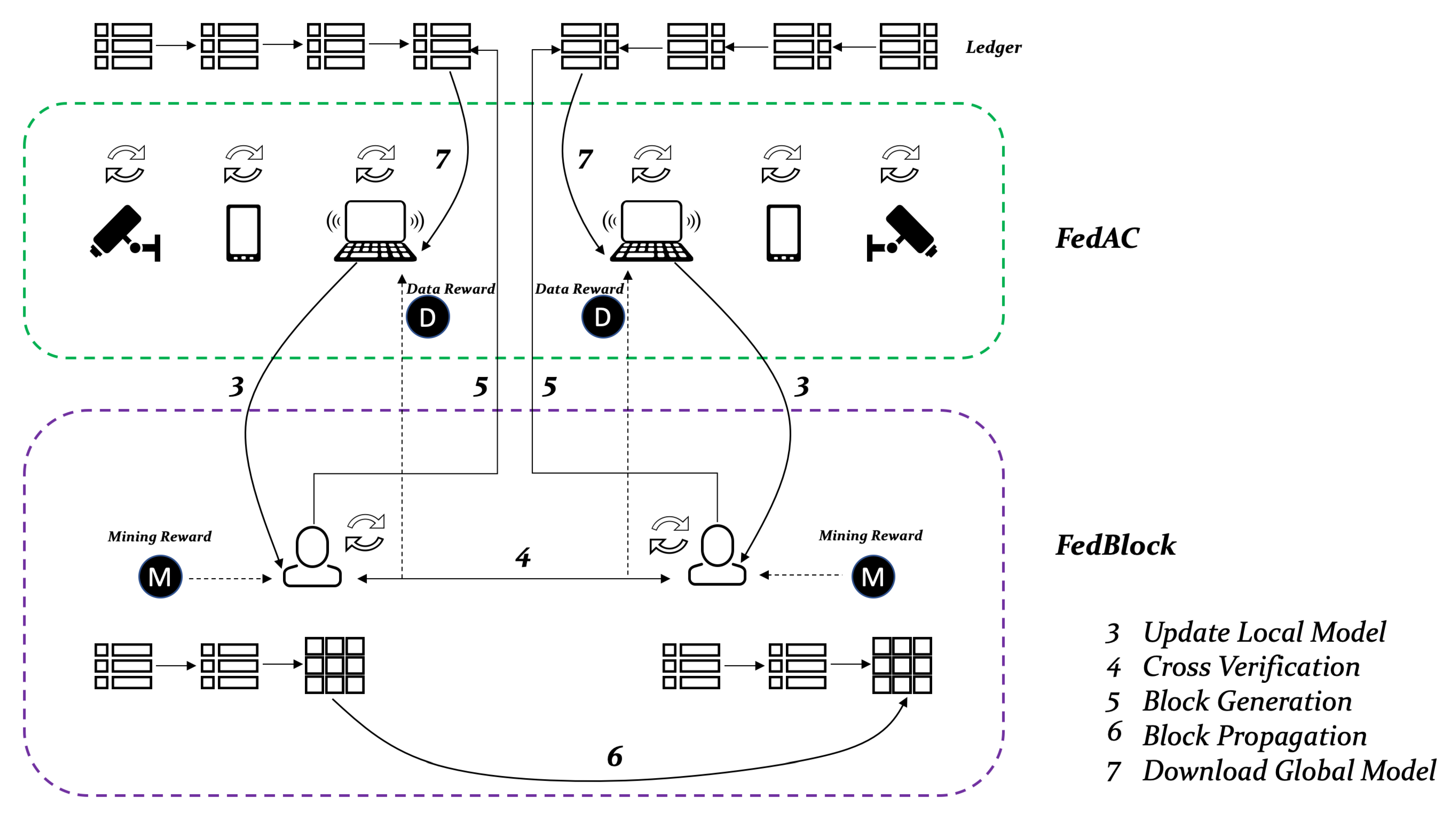
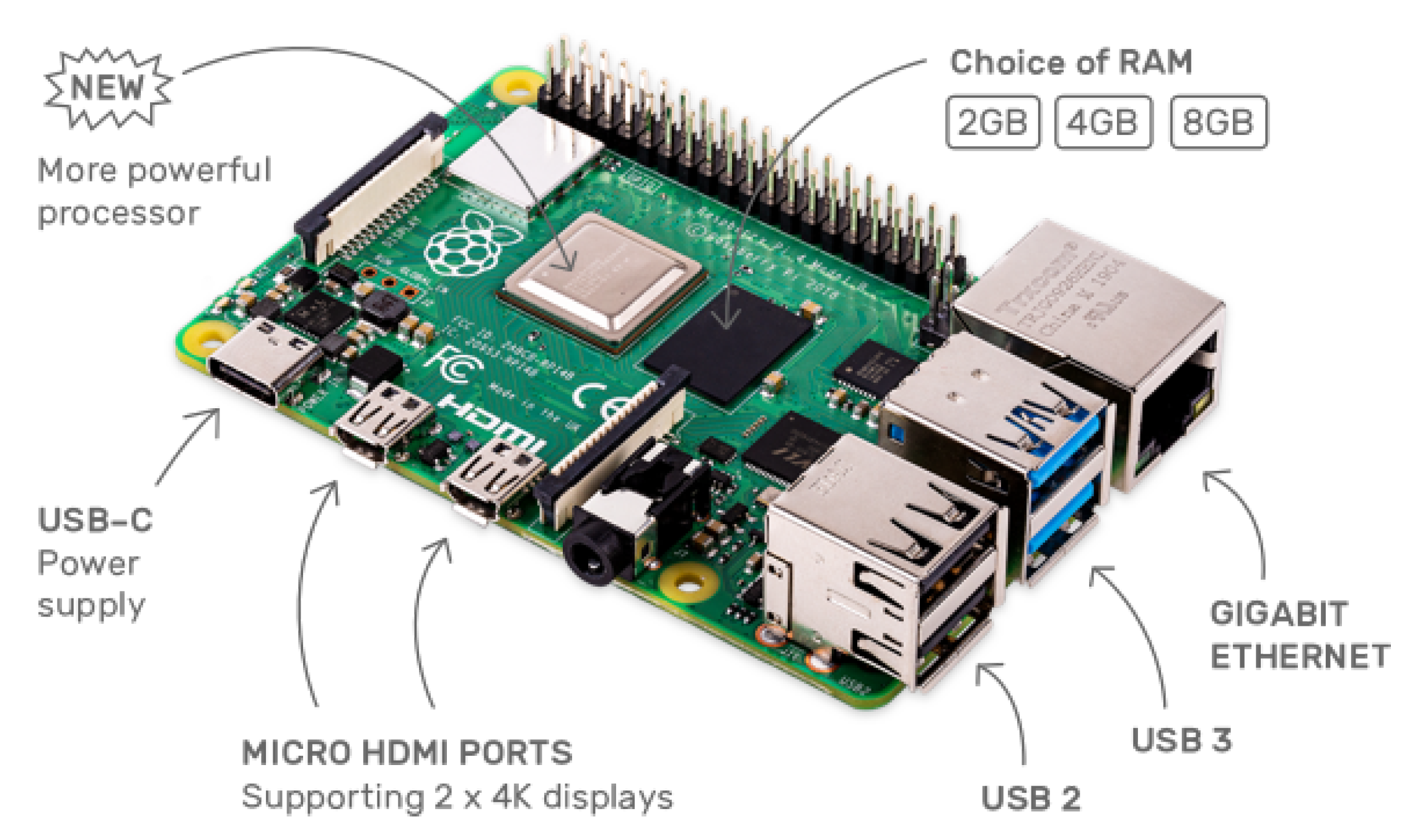
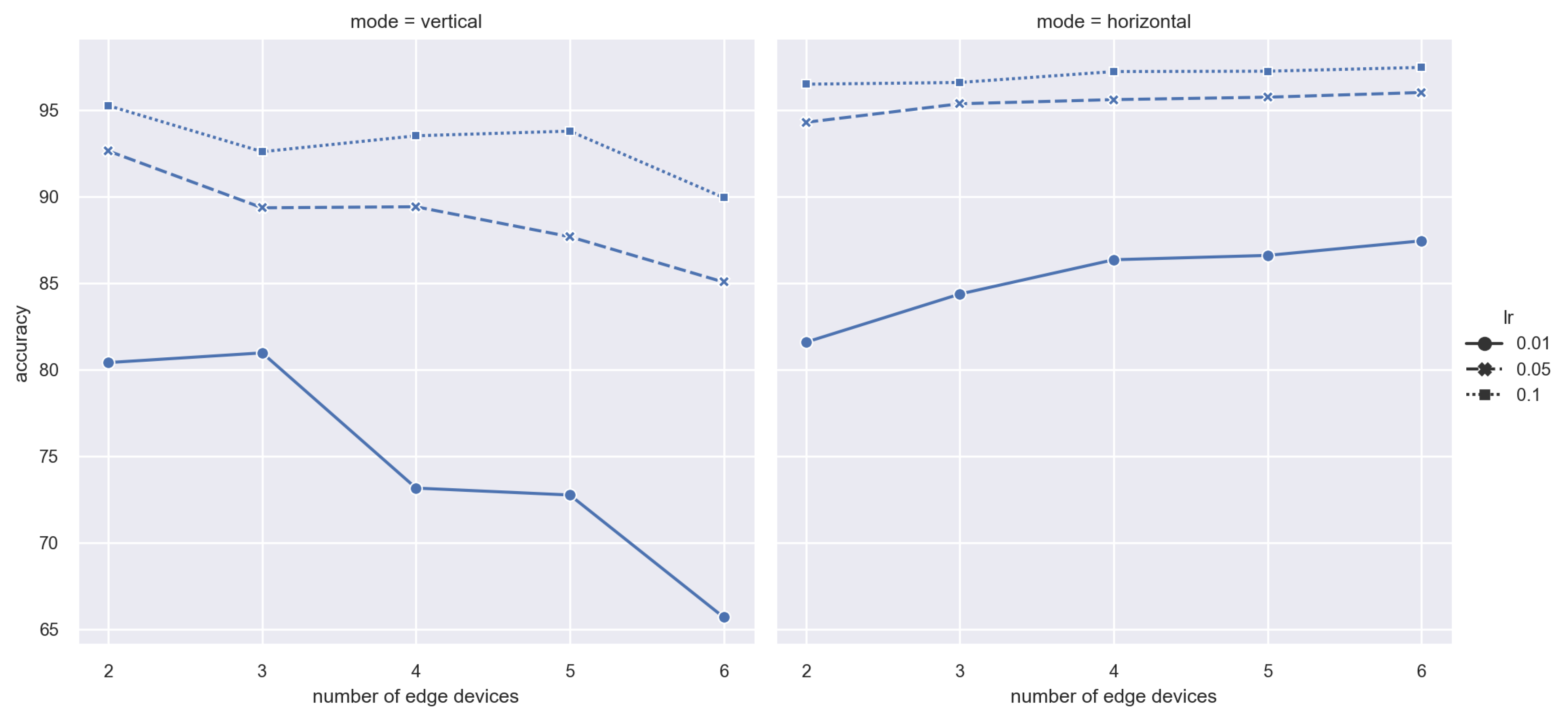
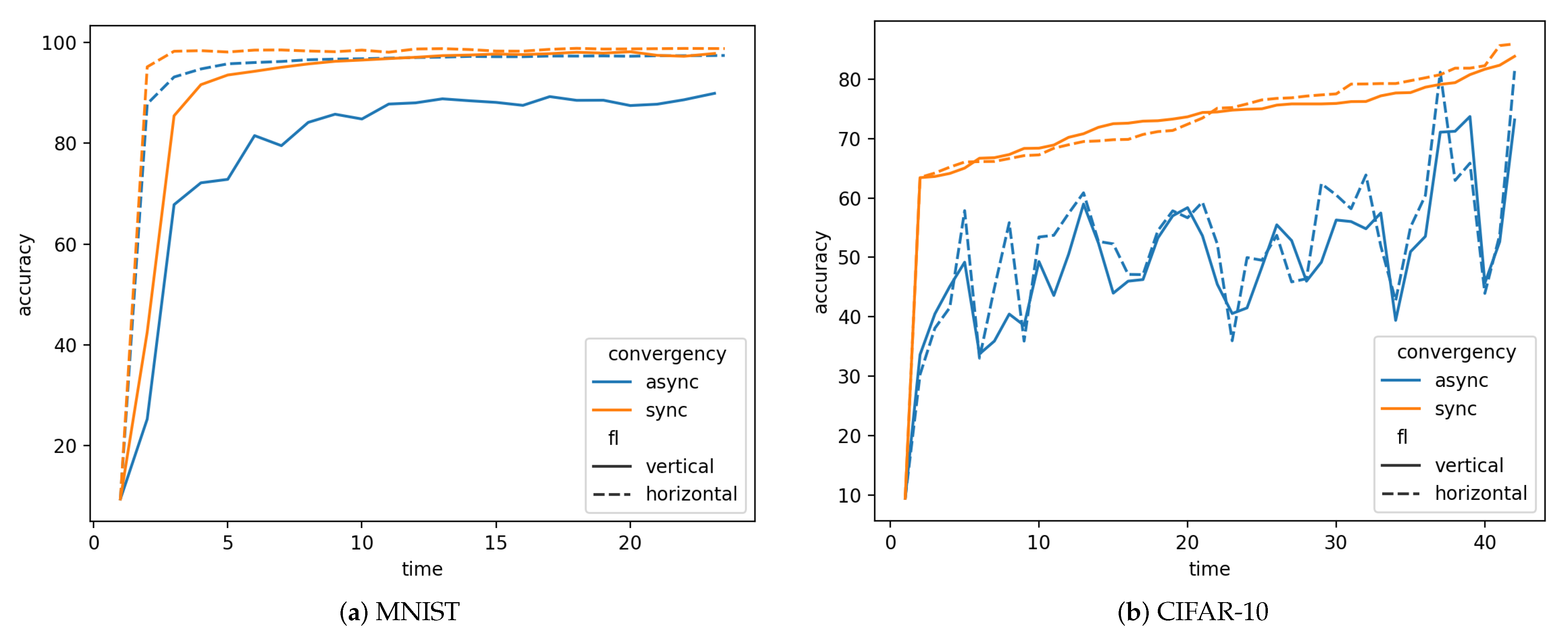

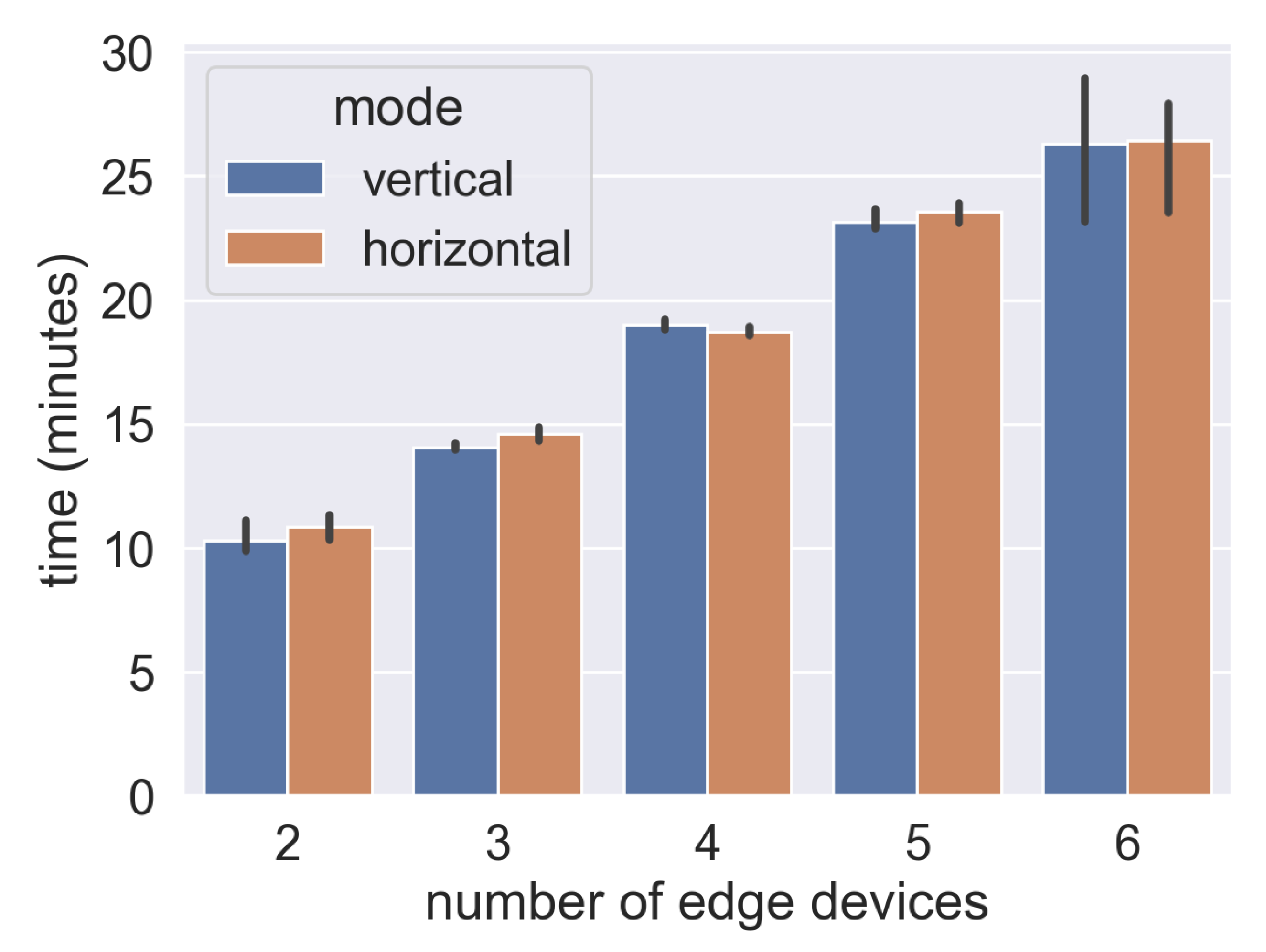

| Notation | Description | Notation | Description |
|---|---|---|---|
| K | Total number of edge devices | Federated learning loss function | |
| The i-th edge device | Staleness coefficient | ||
| M | Total number of miners | Federated learning learning rate | |
| A miner associated with edge device | x | d-dimensional column vector | |
| D | Sample space | y | A scalar value |
| A subset of the sample space on edge device | x and y on edge device | ||
| R | Total number of training rounds | A small positive constant | |
| r | The r-th round | T | Time |
| Final global model | Waiting time | ||
| Local model on edge device in round r | Block generation rate | ||
| Gradient | S | Block size | |
| Model weights | h | Head size in block | |
| Edge device local model weights | Updated local model size in block |
| Items | Description |
|---|---|
| CPU | Broadcom BCM2711, Quad core Cortex-A72 (ARM v8) 64-bit SoC @ 1.5 GHz |
| Memory | 2 GB, 4 GB or 8 GB LPDDR4-3200 SDRAM (depending on model) |
| Wireless LAN | 2.4 GHz and 5.0 GHz IEEE 802.11ac wireless, Bluetooth 5.0, BLE |
| LAN | Gigabit Ethernet |
| USB | 2 USB 3.0 ports; 2 USB 2.0 ports. |
| GPIO | Standard 40 pin GPIO header |
| HDMI | 2 × micro-HDMI ports (up to 4kp60 supported) |
| Display | 2-lane MIPI DSI display port |
| Camera | 2-lane MIPI CSI camera port |
| Audio | 4-pole stereo audio and composite video port |
| Video | H.265 (4kp60 decode), H264 (1080p60 decode, 1080p30 encode) |
| Graphics API | OpenGL ES 3.0 graphics |
| External Storage | Micro-SD card slot for loading operating system and data storage |
| USB-C Power | 5V DC via USB-C connector (minimum 3A) |
| GPIO Power | 5V DC via GPIO header (minimum 3A) |
| Power over Ethernet (PoE) | enabled (requires separate PoE HAT) |
| Working Temperature | Operating temperature: 0–50 degrees C ambient |
Publisher’s Note: MDPI stays neutral with regard to jurisdictional claims in published maps and institutional affiliations. |
© 2021 by the authors. Licensee MDPI, Basel, Switzerland. This article is an open access article distributed under the terms and conditions of the Creative Commons Attribution (CC BY) license (https://creativecommons.org/licenses/by/4.0/).
Share and Cite
Liu, Y.; Qu, Y.; Xu, C.; Hao, Z.; Gu, B. Blockchain-Enabled Asynchronous Federated Learning in Edge Computing. Sensors 2021, 21, 3335. https://doi.org/10.3390/s21103335
Liu Y, Qu Y, Xu C, Hao Z, Gu B. Blockchain-Enabled Asynchronous Federated Learning in Edge Computing. Sensors. 2021; 21(10):3335. https://doi.org/10.3390/s21103335
Chicago/Turabian StyleLiu, Yinghui, Youyang Qu, Chenhao Xu, Zhicheng Hao, and Bruce Gu. 2021. "Blockchain-Enabled Asynchronous Federated Learning in Edge Computing" Sensors 21, no. 10: 3335. https://doi.org/10.3390/s21103335
APA StyleLiu, Y., Qu, Y., Xu, C., Hao, Z., & Gu, B. (2021). Blockchain-Enabled Asynchronous Federated Learning in Edge Computing. Sensors, 21(10), 3335. https://doi.org/10.3390/s21103335








